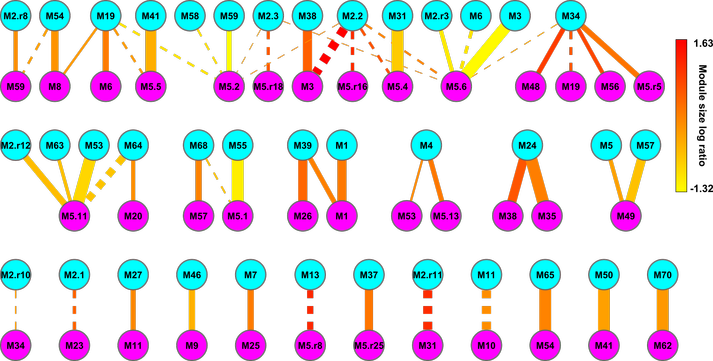
Organizational landscape of regulatory circuitry
Understanding the principles governing the organization and evolution of large-scale biological circuits is a key step to make the ambitious agenda of synthetic biology come true.
(Positions available: This project is currently recruiting PhD and BSc students)
Synthetic biology is the engineering of biology. It aims to design new biological components and to re-design existing natural systems. Engineering is however defined as the creative application of scientific principles to design things that do not exist in nature. Unfortunately, the poor current understanding of the principles governing the organization and evolution of large-scale biological circuits curbs the development of synthetic biology into a true engineering discipline.
We are convinced that by using large-scale comparative systems biology approaches we can gain new insights into the particular adaptions of gene circuits to different lifestyles. This knowledge relating alternative circuit designs to each organism's lifestyle eventually could be exploited by synthetic biology to guide and optimize the design of new biological components.
We first explored that approach by comparing the organizational principles governing the functional architectures of Bacillus subtilis and Escherichia coli. We found that both biotechnologically relevant bacteria have common system-level principles governing their functional architectures, and we provided a comparison of their physiology and particular lifestyle adaptations. In that work, we hypothesize that the large evolutionary distance between these organisms suggests the possible universality among prokaryotes of the discovered common systems principles.
To provide enough data to test this hypothesis and to make large-scale comparative systems biology approaches true we developed Abasy Atlas. To create Abasy (Across-bacteria systems) Atlas we reconstructed the most complete experimentally-supported bacterial regulatory networks by metacurating and integrating datasets from literature and databases, we then predicted their system-level elements. All this information is available in a homogeneous format (JSON). Besides, Abasy Atlas goes beyond genomic functional associations by using a guilt-by-association strategy to provide system-level functional associations allowing to propose functions for genes whose homologs have not been characterized. Thus, Abasy Atlas is a comprehensive atlas of systems, global network properties, and system-level elements shaping regulatory networks across bacteria.
In collaboration with Dr. Andreas Tauch from the Center for Biotechnology (CeBiTec) of Bielefeld University, we reconstructed the most complete experimentally-supported regulatory network of the biotechnologically relevant Corynebacterium glutamicum and, using Abasy Atlas, we comprehensively explored its global organizational properties, system-level features, and functional architecture.
From Abasy Atlas we learn that virtually all the reconstructed bacterial regulatory networks exhibit the same diamond-shaped, three-tier hierarchy predicted by the natural decomposition approach. The convergence of the regulatory networks of disparate bacteria having different lifestyles into a common functional architecture governed by the same organizational principles suggests that evolution only could explore a constrained space of possible regulatory network topologies.
We call to this constrained space the organizational landscape of regulatory networks. The information available in Abasy Atlas will allow us to study and delimit the landscape of possible regulatory network topologies that evolution could explore in bacteria to get a better understanding of the evolutionary forces driving these control networks.
- Freyre-Gonzalez, J.A.*, Escorcia-Rodríguez, J.M., Gutiérrez-Mondragón, L.F., Martí-Vértiz, J. Torres-Franco C.N., Zorro-Aranda, A. System principles governing the organization, architecture, dynamics, and evolution of gene regulatory networks. Frontiers in Bioengineering and Biotechnology 10:888732 (2022) doi:10.3389/fbioe.2022.888732
- Escorcia-Rodríguez, J.M., Tauch, A., Freyre-González, J.A.* Corynebacterium glutamicum regulation beyond transcription: Organizing principles and reconstruction of an extended regulatory network incorporating regulations mediated by small RNA and protein-protein interactions. Microorganisms 9(7):1395 (2021) doi:10.3390/microorganisms9071395
- Escorcia-Rodríguez, J.M., Tauch, A., Freyre-González, J.A.* Abasy Atlas v2.2: The most comprehensive and up-to-date inventory of meta-curated, historical, bacterial regulatory networks, their completeness and system-level characterization. Computational and Structural Biotechnology Journal 18:1228-1237 (2020) doi:10.1016/j.csbj.2020.05.015
- Freyre-González, J.A.*, Tauch, A. Functional architecture and global properties of the Corynebacterium glutamicum regulatory network: novel insights from a dataset with a high genomic coverage. Journal of Biotechnology 257C:199-210 (2017) doi:10.1016/j.jbiotec.2016.10.025
- Ibarra-Arellano, M.A., Campos-González, A.I., Treviño-Quintanilla, L.G., Tauch, A., Freyre-González, J.A.* Abasy Atlas: A comprehensive inventory of systems, global network properties, and systems-level elements across bacteria. Database 2016:baw089 (2016) doi:10.1093/database/baw089
- Freyre-González, J.A.*, Treviño-Quintanilla, L.G., Valtierra-Gutiérrez, I., Gutierrez-Ríos, R.M., Alonso-Pavón, J.A. Prokaryotic regulatory systems biology: Common principles governing the functional architectures of Bacillus subtilis and Escherichia coli unveiled by the natural decomposition approach. Journal of Biotechnology 161(3):278-286 (2012) doi:10.1016/j.jbiotec.2012.03.028